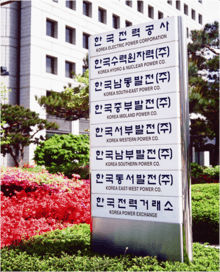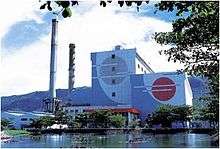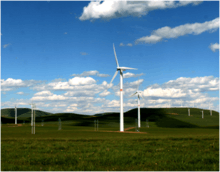Korea Electric Power Corporation
|
| |
| Public | |
| Traded as |
KRX: 015760 NYSE: KEP |
| Industry | Electric utility |
| Founded |
1898 (as Seoul Electric Company) July 1st, 1961 |
| Headquarters | Naju, South Jeolla, South Korea |
Key people |
Cho Hwan-Ik (president and CEO) |
| Products | Electrical power |
| Services | Electricity distribution |
| Revenue |
|
|
| |
|
| |
| Total assets |
|
| Total equity |
|
| Owner |
Korea Finance Corporation (29.94%) Korean government (21.17%) |
Number of employees | 20,603 (2015) |
| Website |
www |
Korea Electric Power Corporation, better known as KEPCO, (한국전력공사: Hanguk Jeollyeok Gongsa NYSE: KEP, KRX: 015760) is the largest electric utility in South Korea,[2] responsible for the generation, transmission and distribution of electricity and the development of electric power projects including those in nuclear power, wind power and coal. KEPCO is responsible for 93% of Korea's electricity generation.[3] The South Korean government (directly and indirectly) owns a 51.11% share of KEPCO. Together with its affiliates and subsidiaries, KEPCO has an installed capacity of 65,383 MW. On the 2011 Fortune Global 500 ranking of the world's largest companies, KEPCO was ranked 271.[4] KEPCO is a member of the World Energy Council, the World Nuclear Association and the World Association of Nuclear Operators. As of August 2011, KEPCO possesses an A+ credit rating with Fitch Ratings,[5] while Moody's has assigned KEPCO an A1 stable rating.[6]
Currently located in Samseong-dong, Seoul, KEPCO headquarters is scheduled to relocate to the city of Naju in South Jeolla Province in August 2014 as part of a government decentralization program.[7] The move, which has been in the works for years has been controversial[8] Hwan-Ik Cho is the president and CEO of KEPCO.
History

KEPCO traces its origins to Hanseong Jeongi Hoesa (Seoul Electric Company), founded in 1898 during the Joseon Dynasty.[9] The announcement of the Chosun Electricity Control Decree by the Colonial Korean government in March 1943 saw the integration of several electric companies into the Korea Electric Power Company. The Korea Electric Company (KECO), established through the integration of the Korea Electric Power Company and two distribution companies, Gyeongsung Electric Company and South Korea Electric Company, opened on July 1, 1961. In 1982, KECO became a wholly government owned entity and was renamed the Korea Electric Power Corporation (KEPCO).[10]
KEPCO was listed on the Korea Composite Stock Price Index (KOSPI) on August 10, 1989 and later in 1994 on the New York Stock Exchange. In 1996, KEPCO was named the prime contractor for the multinational Korean Peninsula Energy Development Organization (KEDO) project to construct a light water reactor nuclear power plant in North Korea,[11] a project which was eventually abandoned in 2006.[12] Following a push by the Korean government to restructure Korea's power industry which began in the mid-1990s, the Act on the Promotion of Restructuring the Electric Power Industry was proclaimed on December 23, 2000,[13] after which the electricity generation business was split up into Korea Hydro & Nuclear Power, a subsidiary responsible for nuclear & hydro power generation, and five thermal power generation companies: Korea South-East Power, Korea Midland Power, Korea Western Power, Korea Southern Power, and Korea East-West Power.
In October 2012, Korea Deposit Insurance Corporation sold its 3.6% of its stake in KEPCO for a fee of around $550 million.[14]
Subsidiaries
KEPCO comprises six power generation companies and four subsidiaries in related business areas. It also owns a stake in four affiliated companies.[15]
Power generation companies
- Korea Hydro & Nuclear Power (KHNP): operates 21 nuclear power plants and 27 hydropower plants in Korea which account for 18,265 MW in total capacity (as of Dec. 2010).
- Korea South-East Power (KOSEP): with 8,976 MW in total capacity (as of Dec. 2010), KOSEP operates the Samcheonpo Thermal Power Site Division and the Yeongheung Thermal Power Plant.
- Korea Midland Power (KOMIPO): operates the Boryeong Thermalelectric Power Plant Site Division and the Yeongheung Thermal Power Plant, and possesses 9,399 MW in total installed capacity (as of Dec. 2010).
- Korea Western Power: operates the Taean Thermal Power Plant and manages a total installed capacity of 9,604 MW via 8 soft coal-fired units, 24 LNG combined cycle units, 4 oil-fired units and 4 pumped storage power plant units.
- Korea Southern Power (KOSPO): operates the Hadong Thermal Power Site Division and manages 9,638 MW in total installed capacity as of Dec. 2010.
- Korea East-West Power: operates the Dangjin and Honam Coal Fired Power Plants, and manages a total of 9,510 MW in installed capacity as of Dec. 2010.

Other subsidiaries
- KEPCO E&C: KEPCO Engineering & Construction (KEPCO E&C) is a comprehensive engineering company which develops and designs nuclear and thermal power plants. KEPCO owns a 77.94% share of KEPCO E&C.
- Korea Nuclear Fuel (KNF): Korea Nuclear Fuel specializes in the design and manufacture of nuclear fuel, as well as fuel engineering services. KNF is the world's only producer of nuclear fuel for both light-water (LWR) and heavy water (HWR) reactors. KEPCO's share of KNF stands at 96.4%.
- Korea Plant Service & Engineering: Korea Plant Service & Engineering is 75% owned by KEPCO. It provides maintenance services for Korea's power generation, transmission, transformation and industrial facilities.
- Korea Electric Power Data Network: 100% wholly owned by KEPCO, Korea Electric Power Data Network provides IT services covering the full range of electric power from generation and transmission to distribution and sales.
Affiliated companies
- Korea Electric Power Industrial Development Corporation
- Korea Gas Corporation
- Korea District Heating Corporation
- LG UPlus Corporation
Operations
Domestic activities
In Korea, KEPCO primarily provides electricity to include industrial, commercial, residential, educational and agricultural customers. As of December 31, 2011, KEPCO had a total installed generating capacity of 67,001MW produced by 503 generation units including nuclear, oil, coal, liquified natural gas, hydro, wind and solar sources. The length of KEPCO's transmission lines stood at 31,249 circuit kilometers as of end-2011.[16][17][18]
Nuclear business
KEPCO's involvement in the nuclear energy sector ranges from design and engineering of the nuclear power plant to nuclear fuel, commissioning and operation, maintenance and decommissioning. Construction of KEPCO nuclear power plants is undertaken by major Korean construction companies, while the manufacture of key elements of a nuclear power plant is done by companies including Doosan Heavy Industries & Construction and Westinghouse Electric Company. In 2009, KEPCO won a bid to construct four units of the APR1400 reactor in the United Arab Emirates.[19]
In October 2013 a vice-president of KEPCO, amongst about 100 people, was indicted for falsifying safety documents.[20]
Overseas activities

KEPCO's overseas forays started in 1993 when the company was awarded a technical consulting contract for maintenance on the Guangdong nuclear power plant in China. At present, KEPCO is involved in projects in 13 countries around the world.[21] In 1996, KEPCO entered the Philippines power market when it was awarded the contract for the refurbishment and operation of the Malaya thermal power plant. In 1996, KEPCO won the bid to construct the Ilijan gas-fired combined cycle power plant, a 1,200MW build-operate-transfer project. Today, KEPCO operates four power plants in the Philippines, including the Naga Power Plant Complex and the Cebu Circulating Fluidized Bed Combustion Power Plant, while the company's operations account for 12% of the country's installed generation capacity.[15] In April 2012 KEPCO contracted ICPO to raise $400m to buy into Boutique Coal in Australia to benefit from cheap coal briquettes which improved burn efficiency by up to 30% reduced SO
x and NO
x by >80% and reduced CO
2. KEPCO scientists tried to get IP details and reverse engineer the product for their own use. BC cancelled all association with KEPCO due to an attempt to circumvent and declared KEPCO less than reputable.

In the area of transmission and distribution consultation, KEPCO has undertaken projects in Myanmar, Cambodia, Vietnam, Indonesia, Libya, Ukraine, Paraguay and Egypt.[22] KEPCO entered the wind power industry in China with its involvement in the Gansu wind project, on which the first stage of construction began in 2007. KEPCO also holds an equity share in wind projects in Inner Mongolia and Riaoning, as well as in China's Shanxi Province. In 2010, a KEPCO-led consortium including Samsung C&T and Korean firm Techint was awarded a contract to build and operate the Norte II combined cycle gas power plant in the Mexican state of Chihuahua.[23] In 2005, KEPCO began supplying electricity to the Kaesong Industrial Region in North Korea.[24]
Resources development
In order to raise its fuel self-sufficiency rate to 60% by 2020,[25] in 2010, KEPCO acquired the Bylong Coal Mine in Australia from Anglo American PLC.[26] Also in 2010, KEPCO bought a 20% stake in Bayan Resources in Indonesia, thus allowing the company to raise its coal self-sufficiency rate by 7 million tons annually from 2015.[27] In 2009, KEPCO bought a 1.5% stake in Indonesia's Adaro Energy, thus securing 3 million tons of coal annually.[28] Regarding uranium procurement, in 2009, KEPCO acquired a 17% share of Denison Mines Corp. in Canada, as well as a 10% stake in Areva SA's Imouraren uranium mine in Niger. In 2010, KEPCO signed an agreement with Areva to jointly develop uranium mines.[29]
Smart grid
In early 2010, KEPCO announced it would invest over US$7 billion in its smart grid business by 2030 to make electricity distribution more efficient and decrease Korea's greenhouse gas emissions.[30] KEPCO is one of the 168 Korean and foreign companies taking part in the Jeju Smart Grid Demonstration Project, begun following the announcement of Korea's National Smart Grid Roadmap in 2009.[31] In June 2011, it was announced that KEPCO would collaborate with IBM to build a Total Operations Center at the Jeju Smart Grid Test-Bed Demonstration Complex.[32]
See also
- Jang Young-sik, KEPCO president from May 1998–April 1999
- Energy in South Korea
- Nuclear power in South Korea
- Smart grids in South Korea
- Jeju Smart Grid Demonstration Project in Korea
- Economy of South Korea
- Environment of South Korea
- Lists of public utilities
- List of Korea-related topics
References
- 1 2 3 4 5 "Korea Electric Power Corp (015760:Korea Stock Exchange (Koscom))". businessweek.com. Retrieved 2013-05-02.
- ↑ "Korea Electric Power Corp. ADR". Morningstar. 2013. Retrieved 2013-02-03.
- ↑ International Business Machines (2011-03-10). "IBM Expands Global Intelligent Utility Network Coalition to Advance Smart Grid Development". IBM News room. Retrieved 2013-02-02.
- ↑ Fortune (2011-07-25). "Fortune Global 500: 271. Korea Electric Power". CNN Money. Retrieved 2013-02-02.
- ↑ Yonhap News Agency (2011-05-25). "Kepco keeps A-plus credit rating". Korea JoongAng Daily. Retrieved 2013-02-02.
- ↑ Moody's Investors Services (2009-08-01). "Korea's 5% Electricity Tariff Hike Is Credit Positive for State-Run KEPCO" (PDF). Retrieved 2013-02-02.
- ↑ Jung Sung-ki (2011-11-03). "Move to Naju is part of governmental decentralization scheme". The Korea Times. Retrieved 2013-02-02.
- ↑ "Inefficient moves". Korea JoongAng Daily. 2007-05-09. Retrieved 2013-02-02.
- ↑ Moon-Hyon Nam (3–5 August 2007). "Early history of Korean electric light and power development". IEEE Conference on the History of Electric Power, 2007: 192–200. doi:10.1109/HEP.2007.4510266.
- ↑ Baumann, Jim (2007-06-07). "KEPCO Plays Key Role in South Korean Economy". Directions Magazine. Retrieved 2013-02-02.
- ↑ KEDO (July–August 1997). "'KEDO to break ground on nuclear project in North Korea,' Statement by the Korean Peninsular Energy Organization (KEDO), 14 August 1997". Disarmament Diplomacy (17). Retrieved 2013-02-02.
- ↑ KEDO. "About Us: Our History". Retrieved 2013-02-02.
- ↑ Park Jong-Keun (14–16 May 2001). "Power system and technical issues in South Korea" (PDF). First Workshop on Power. Grid Interconnection in Northeast Asia, Beijing, China,. p. 2. Retrieved 2013-02-02.
- ↑ Elzio Barreto (9 October 2012). "S.Korea's KDIC raises $550 mln in upsized KEPCO sale-source". Reuters.
- 1 2 KEPCO (2012). "Annual Report 2011" (PDF). Retrieved 2013-02-02.
- ↑ "Kazakhstan and South Korea negotiating on construction of a nuclear power plant". Tengri News. 2011-08-22. Retrieved 2013-02-02.
- ↑ Yahoo!. "Korea Electric Power Co. (KEP)". Yahoo Finance. Retrieved 2013-02-02.
- ↑ "Korea Electric Power Corp (015760:Korea SE)". Bloomberg Businessweek. 2013-02-01. Retrieved 2013-02-03.
- ↑ Choi Kyung-hwan (2010-08-30). "Power industry laid a solid foundation for growth". The Korea Times. Retrieved 2013-02-02.
- ↑ "Indictments for South Korea forgery scandal". World Nuclear News. 10 October 2013. Retrieved 14 October 2013.
- ↑ Lee Kyung-min (2011-06-23). "KEPCO Aims to Become a Global Top 5 Energy & Engineering Company". Korea IT Times. Retrieved 2013-02-02.
- ↑ Reuters. "Profile: Korea Electric Power Corp (KEP)". Reuters. Retrieved 2013-02-02.
- ↑ Jung Seung-hyun (2010-09-09). "Kepco completes deal to supply electricity in Mexico". Joongang Daily. Retrieved 2013-02-02.
- ↑ Park Young-chul (2005-03-14). "Kaesong Power Supply to Reverse Current After 57 Years". The Chosun Ilbo. Retrieved 2013-02-02.
- ↑ Kim Tae-gyu (2011-07-06). "KEPCO aims to be world top-five energy firm". The Korea Times. Retrieved 2013-02-02.
- ↑ Nam In-soo (2010-07-05). "Kepco Buys 100% Of Bylong Coal Mine For A$403 Million From Anglo". ADVFN. Retrieved 2013-02-02.
- ↑ Cho Mee-young (2010-07-21). "KEPCO to invest $512 mln in Bayan Resources". Reuters. Retrieved 2013-02-02.
- ↑ Nam Kwang-sik (2009-07-23). "Korea Electric Power buys into Indonesian coal producer". Yonhap News Agency. Retrieved 2013-02-02.
- ↑ Oh Hae-young (2010-02-09). "KEPCO Signs an Uranium Mining Partnership with Areva SA". Korea IT Times. Retrieved 2013-02-02.
- ↑ Cho Mee-young (2011-02-18). "KEPCO to invest $7.2 bln in smart grid by 2030". Reuters. Retrieved 2013-02-02.
- ↑ Zpryme (2011-08-03). "South Korea: Smart Grid Revolution". Global Smart Grid Federation. Retrieved 2013-02-02.
- ↑ Penton Media (2011-06-29). "Korea to Build Total Operations Center at Jeju Smart Grid Demo Complex". Transmission & Distribution World. Retrieved 2013-02-02.